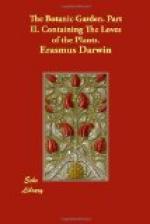I remember seeing a print, in which was represented a shrivelled hand stretched through an iron grate, in the stone floor of a prison-yard, to reach at a mess of porrage, which affected me with more horrid ideas of the distress of the prisoner in the dungeon below, than could have been perhaps produced by an exhibition of the whole person. And in the following beautiful scenery from the Midsummer-night’s dream, (in which I have taken the liberty to alter the place of a comma), the description of the swimming step and prominent belly bring the whole figure before our eyes with the distinctness of reality.
When
we have laugh’d to see the sails conceive,
And
grow big-bellied with the wanton wind;
Which
she with pretty and with swimming gate,
Following
her womb, (then rich with my young squire),
Would
imitate, and sail upon the land.
There is a third sister-feature, which belongs both to the pictorial and poetic art; and that is the making sentiments and passions visible, as it were, to the spectator; this is done in both arts by describing or portraying the effects or changes which those sentiments or passions produce upon the body. At the end of the unaltered play of Lear, there is a beautiful example of poetic painting; the old King is introduced as dying from grief for the loss of Cordelia; at this crisis, Shakespear, conceiving the robe of the king to be held together by a clasp, represents him as only saying to an attendant courtier in a faint voice, “Pray, Sir, undo this button,—thank you, Sir,” and dies. Thus by the art of the poet, the oppression at the bosom of the dying King is made visible, not described in words.
B. What are the features, in which these Sister-arts do not resemble each other?
P. The ingenious Bishop Berkeley, in his Treatise on Vision, a work of great ability, has evinced, that the colours, which we see, are only a language suggesting to our minds the ideas of solidity and extension, which we had before received by the sense of touch. Thus when we view the trunk of a tree, our eye can only acquaint us with the colours or shades; and from the previous experience of the sense of touch, these suggest to us the cylindrical form, with the prominent or depressed wrinkles on it. From hence it appears, that there is the strictest analogy between colours and sounds; as they are both but languages, which do not represent their correspondent ideas, but only suggest them to the mind from the habits or associations of previous experience. It is therefore reasonable to conclude, that the more artificial arrangements of these two languages by the poet and the painter bear a similar analogy.
But in one circumstance the Pen and the Pencil differ widely from each other, and that is the quantity of Time which they can include in their respective representations. The former can unravel a long series of events, which may constitute the history of days or years; while the latter can exhibit only the actions of a moment. The Poet is happier in describing successive scenes; the Painter in representing stationary ones: both have their advantages.




